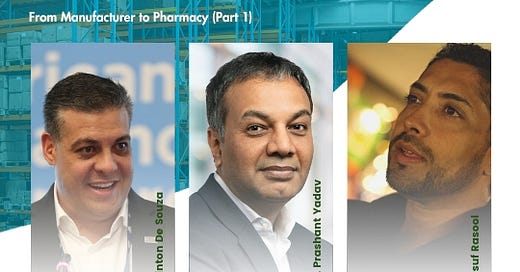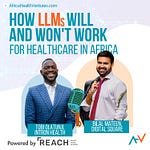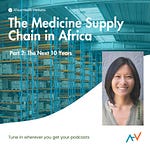What does it take to move a pack of medicines from a factory in India to the shelves of a mom-and-pop pharmacy in Zambia? In this episode, we explore the world of the medicine supply chain in Africa, as told by the people who run it. Along the way, we unpack the market dynamics which limit access to low-cost, essential medicines.
Our lineup includes:
Yusuf Rasool, Director of Global Market Access at MSD/Merck
Clinton De Souza, former Director of Public Health for Imperial Logistics (now DP World), Managing Partner at Celsian Consulting
Michael Moreland, CEO and Founder, Field Intelligence
Sidharth Rupani, Senior Advisor for Supply Chain, The Global Fund
Mila Nepomnyashchiy, Lead Advisor, Center for Innovation and Impact, USAID
Dr. Prashant Yadav, Senior Fellow at the Center for Global Development, Affiliate Professor at INSEAD and Lecturer at Harvard Medical School
Listen now wherever you get your podcasts (Apple Podcasts, Spotify, Overcast, etc.).
Stay tuned for Part 2, when we look at the future trends which are going to dramatically change this supply chain and highlight a few of the new ventures which are leading the way.
Connect with Africa Health Ventures
📰 Sign up for our newsletter to stay informed about what’s going on with healthcare ventures in Africa
🪙 Nominate a startup for seed funding
👍 Follow us on LinkedIn
🎙️ Subscribe to this podcast
In this episode, we cover
(2m54) - Setting the stage: we introduce several of the key actors in the medicine supply chain, including manufacturers, distributors, and pharmacies. Dr. Prashant Yadav highlights the key role of Ministries of Health as well as the disruptive influence of social entrepreneurs.
(8m27s) - Yusuf Rasool of MSD/Merck describes the role of large pharmaceutical companies and why it is difficult for a large multinational to operate directly in 54 different African countries.
(10m57s) - Clinton De Souza digs into two of the structural problems in the medicines market which makes it difficult for distributors to deliver low-cost essential medicines.
(19m07s) - From the perspective of Five Star Pharmacy in Zambia, we look at the working capital gap which prevents small pharmacies from making the full range of medicines available to people.
(21m49s) - Michael Moreland of Field Intelligence describes the role of social entrepreneurs and embedded financing in allowing small pharmacies to increase product availability.
(29m17s) - Recap of the episode so far and teaser for Part 2
Learn More
Health Product Supply Chains in Developing Countries - This 2015 paper from Dr. Prashant Yadav summarizes the key actors and common challenges of medicine supply chains in Sub-Saharan Africa.
How Local Innovation Can Drive the Global Development Agenda - This 2023 piece from Dr. Prashant Yadav highlights the importance of new social entrepreneurs in addressing gaps in the private and public medicine supply chain.
Innovations in Digitizing Health Supply Chains in Africa - This 2023 market intelligence report from Salient Advisory highlights some of the key areas of the medicine supply chain where startups in Africa are most active.
How MSD/Merck is improving access to healthcare - This page highlights a few of the affordability solutions that MSD/Merck’s Access to Medicines team is working on around the world.
Imperial Logistics is one of the largest medicine distributors on the African continent.
Five Star Pharmcies is a chain of retail pharmacies in Zambia founded by Lloyd Matowe with the support of Clinton De Souza.
Field Intelligence is a social enterprise providing planning, fulfilment, and financing of pharmaceuticals to over 35,000 points of care in Nigeria and Kenya, including government clinics, retail pharmacies and drug shops, hospitals and telehealth providers.
Was the $9.5B health supply chain 'a waste of USAID's money'? - Earlier this month, Devex published a(nother) searing indictment of USAID’s global health supply chain program. The controversy surrounding this highly centralized, donor-funded program is one of the reasons why now is a good time to take a look at what’s working (and what’s not) in private sector medicine supply chains. In Part 2 of this episode, we’ll touch on a few of the differences and linkages between what we describe in Part 1 and certain donor-driven supply chains.













Share this post